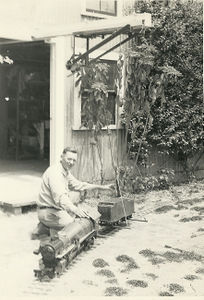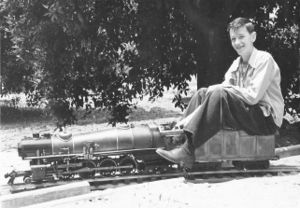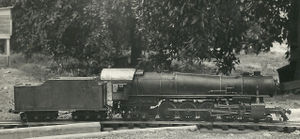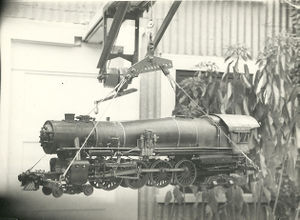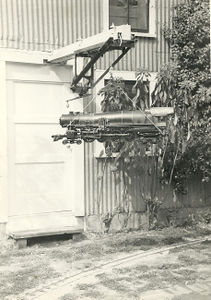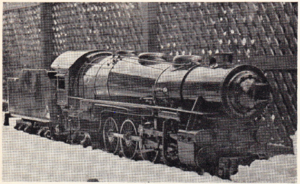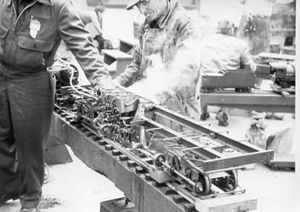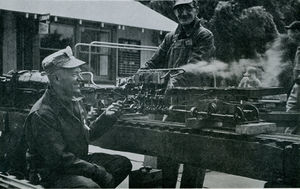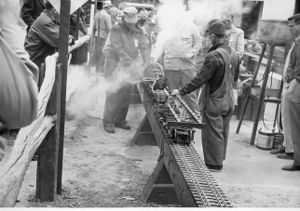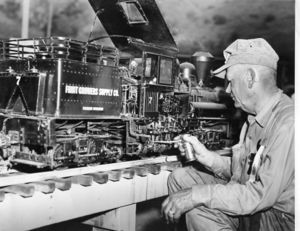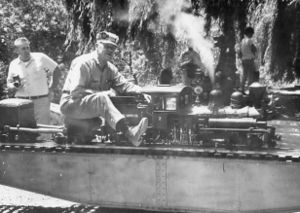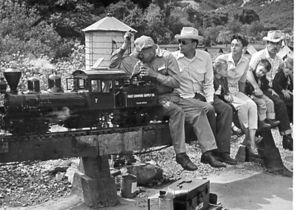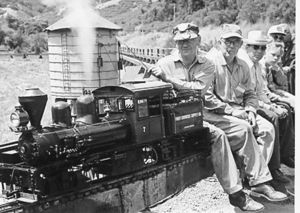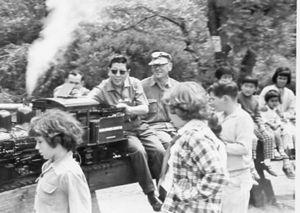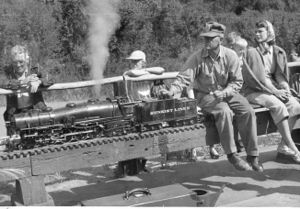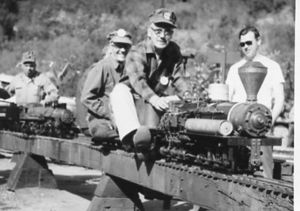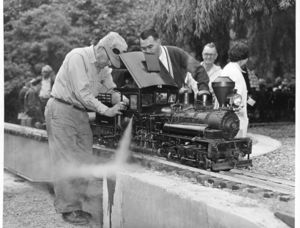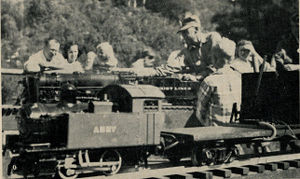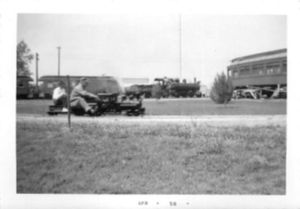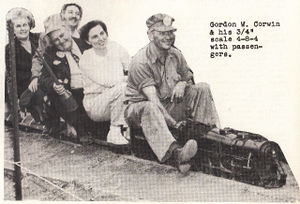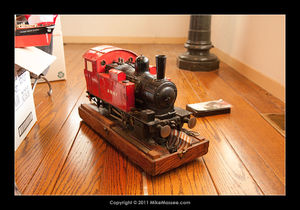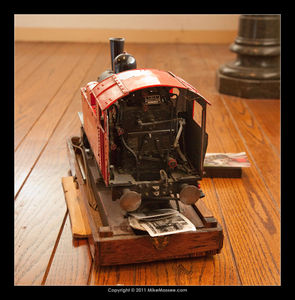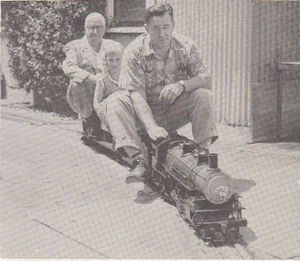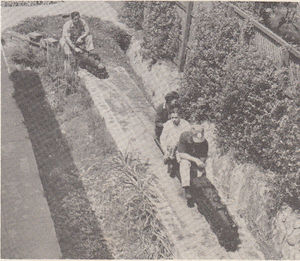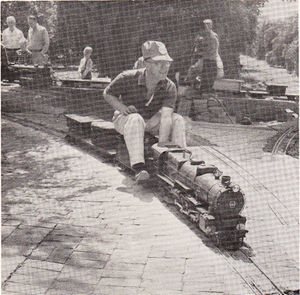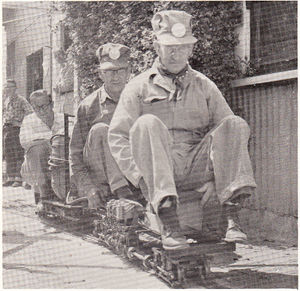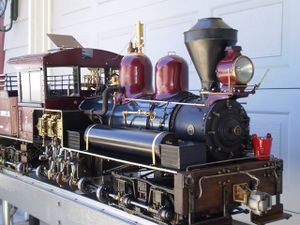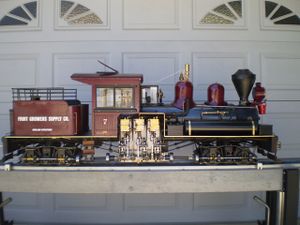Gordon Corwin
Gallery
3/4 inch scale 4-8-4 built by Gordon Corwin of Highland, California. Overall weight with tender is 315 pounds, with two cylinder steam feedwater pump. Walsheart Valve Gear and steam operated cylinder cocks. From Railroad Model Craftsman, Ocotber 1949.
Gordon Corwin's famed Fruit Growers Supply Co. # 7 SHAY... It was the CHASSIS only, operating on compressed air at the old track of GGLS in Oakland's Redwood Regional Park. The guy at left in coveralls is Gordon Corwin. To the right, is the late GGLS member Louis Lawrence. Photo circa 1951. Photo by Harry Dixon, submitted by Ken Shattock.
Gordon Corwin of Southern California Live Steamers at the Golden Gate Live Steamers Spring Meet, 1956, feeding steam from his locomotive to the engine of his Shay with the able assistance of Louis Lawrence. Photo by Harry Dixon. From The North American Live Steamer, Vol 1 No 5, 1956.
Gordon Corwin's Shay running at LALS track, about April 1958. This is a view as from the south side looking north past the No. 30 T&T RR coach to the Oahu RR. train heading east. Chaski.org
Mark Piper and his 1-1/2 inch scale Early American coming alongside Gordon Corwin at the throttle of his narrow gauge 1-1/2 inch scale Shay Engine at the Los Angeles Live Steamers Golden Spike ceremony, May 5, 1957.
Gordon W. Corwin and his 3/4 inch scale 4-8-4 with passengers.
Dedicated Live Steamer
- My father was Gordon Corwin (Sr.) and I grew up in Highland, California where he had his home machine shop and built two 3/4 inch scale and one 1-1/2 inch scale live steam locomotives over many many years. As a young boy, I recall that he began this hobby actively in around 1946 and remained unshakably dedicated to building and running the engines and to sharing his enthusiasm and joy of live steam locomotives until he passed away in 1968. He was passionate about mastering the detail and perfection of all that he built, and spent countless hours over about a 20 years working happily, as time allowed, in his machine shop located at back of the house. The intricate engineering and machining skills involved along with steam locomotives themselves were truly 'in his blood'.
- "ANNY" was the last of the 3 locomotives that he built. I remember with great affection my father building this cute little switching engine, which won constant praise from many who admired her, including the immediate family and fellow hobbyists alike.
- Gordon Corwin, Oceanside CA.
Sunkist Lines
The North American Live Steamer, Volume 1 Number 8
Sunkist Lines Annual Invitational Run
For the past six or eight years Sunkist Lines (which is the name of my layout) has invited the Southern California Live Steamers to my place for an annual run. Since I am located 75 miles from Los Angeles area, only about 10 or 12 locomotives show up for the affair. However, about 150 people usually come.
The track consists of about 750 feet of 3-1/2 inch and 4-3/4 inch gauge laid ground level. The main line is a 400 foot loop with many curves running around the house and through my orange grove (hence the name - Sunkist Lines). There is a passing track of about 80 feet and a wye makes up the balance. There are two grades of 1% and 1-3/4%. Six stub switches are in the system.
The natural grade of the ground was about 4%, which made it necessary to put in a 5 foot high fill at one end of the loop.
- Gordon W. Corwin
- 6988 Church Street
- Highland, California
Joe Nelson with his 1 inch 4-4-2. Dick Jackson, Dean of S.C.L.S. on the rear.
Gordon Corwin with Mark Piper on the front end and Gordon Sherwood on the rear. Corwin's 1-1/2 inch narrow gauge (4-3/4 inch gauge) Shay running on a portable compressed air tank.
Shay Progress 1956
Brotherhood of Live Steamers
News from the Pacific Region
Harry Dixon, Hayward, California
The North American Live Steamer, Volume 1 Number 4
Gordon Corwin of the Southern California Live Steamers club sent good news that he now has his 1-1/2 inch narrow gauge Shay operating on air.
The entire chassis with drive wheels and engine are considered 95% complete.
After a 10-hour break in test with light oil and graphite, the throttle was cracked open another notch, which brought the speed indicator up to 1725 RPM.
With a gearing ration of 2 to 1 it would take 317 RPM to make 1 mile per hour or 1268 RPM to make 4 miles per hour, which is considerable over track speed of a prototype. However, it is felt that a miniature engine of this type would have to do 4 to 5 miles per hour to be impressive.
Next on his agenda is the boiler, and then we hope to give you a later report on the progress of this very fine engineering accomplishment.
Hex Heads
It's Easy to File Hexes
The North American Live Steamer, Volume 1 Number 6
Many times it is necessary to file hexes on motion pins, bolts, etc. This was always a disagreeable job for me until I developed the method here described, and which took most of the pain out of it. This may not be a new idea, but it is certainly fast and quite accurate.
First, make a safe file from a 6 or 8 inch flat mill file, by grinding the edge teeth off smooth. This smooth edge will protect the flange of the pin, if the pin is to have a flange at the base of the hex head.
We will take a 5-40 motion pin with flange for our example. Turn the "hex head to be" in the lathe to a full 3/16 inch and the required length, say 1/8 inch. Thurn the flange, say 1/32 inch thick and 1/4 inch in diameter. Of course the shank will be 1/8 inch in diameter since it is a 5-40 and whatever the desired length.
With the work still in the three jaw chuck, move jaw Number 1 vertical. With the safe file smooth edge next to the flange, file about five or six strokes, with even pressure. Be sure to keep the file square with the work in both directions. Then move Number 2 jaw straight down, filing the next face, counting the strokes. Then move Number 3 jaw straight up and file face Number 3--and so on around the head. In other words, we are using the three, 120 degree chuck jaws as a dividing head and moving only 60 degrees, six times to get the hex.
At the end of the operation a little truing up, probably, will be necessary. As a guide th ehead can be filed to fit the size socket wrench which will be used on it.
It is not a bad idea to practice on a round lead pencil or a small round piece of wood.
This method certainly paid off in building my Shay engine as there were 27 hex heade dmotion pins with flanges to be made.
- Gordon W. Corwin
- 6986 Church Street
- Highland, California
Carl Herrera Restoration
From Chaski.org
Postwarbob posted:
- Carl Herrera now owns this engine . He has totally restored it to its original beauty. He spent many hours repiping and repairing worn out parts . The purple paint is still the original paint but most of the black paint is new.
David Rohrer posted:
- The Shay really looks great, I remember it from when Francis Moseley owned it, was pleased to see you even have the cable wrapped around the sand dome.
Gordon Corwin Meets
From The Miniature Locomotive, July/August 1953
By C. S. Chovil, Secretary, Southern California Live Steamers
The Gordon Corwin annual picnic and engine meet proved very popular with S.C.L.S.. the attendance was more than in the past years, the day was perfect and the tracks of the SUNKIST LINES in good condition. Many members brought their lunches as invited, came early and stayed until the last boiler was blown down. The roster of locomotives was as follows: Jim Keith's 1 inch scale Hudson; Barny Shrive's 3/4 inch scale N.Y.C. Niagara; Irene Lewis's 1 inch scale six-wheel switcher operated by Bob Harpur; Milton Uhler's 3/4 inch Tom Thumb; John Matthew's 3/4 inch English Shunting engine "Pug"; Burt Petersen's 3/4 inch Northern; Bill wightman's 3/4 inch 2-4-4 tank engine; Andy Wightman's 3/4 inch Mogul and J.D. Hillyard's 3/4 inch Atlantic.
